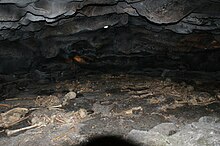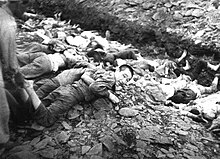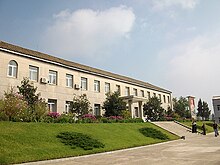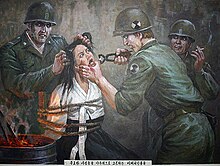Massacre in South Korea


A series of massacres in South and North Korea occurred between 1948 and 1951 against the background of the partition of Korea into North Korea and South Korea (1945) and the Korean War (1950-1953).
After the Second World War ended with the capitulation of Japan in 1945 , the Japanese colonial empire collapsed and the Korean peninsula was occupied by the armed forces of the USA and the Soviet Union . As a result, the two powers established zones of occupation and administered the part of Korea occupied by their armed forces through a military government . The parliamentary elections held on May 10, 1948 in South Korea resulted in a militant anti-communist government.
Exemplary listing of massacres
The following massacres should be mentioned because of their importance:
- Jeju massacre : As a result of an alleged communist uprising by fishermen and farmers on the island of Jeju on April 3, 1948, more than 270 of 400 villages were wiped out and numerous people were killed. The estimates vary between 30,000 and 60,000 people or more, with a total population of the island of 300,000 people at the time.
- Yeosu – Suncheon Rebellion , October 1948
- Sinchon massacre , 1950: According to North Korean sources, 35,383 civilians were killed by US forces and their mostly South Korean supporters in the course of 52 days . That would correspond to a quarter of the region's population. The Sinchon Museum of United States War Atrocities has been located there since 1958. However, knowledge about the Sinchon massacre is limited as Sinchon is located in North Korea and is therefore not accessible for independent investigations.
- Bodo League massacre : The massacre committed in the summer of 1950 is one of the most terrible atrocities committed against allegedly proven or alleged communist members or supporters of the Bodo League . Around 100,000 to 200,000 people, mostly uninvolved civilians , were executed in and around Daejeon .
- Namyangju Massacre , 1950-1951; In 2008 in Namyangju , among the bodies of 460 people, at least 23 children under the age of 10 were found.
- Ganghwa massacre , 1951
- Gwangju massacre , 1980
Culture of remembrance
More than fifty years later, in 1999, the President of South Korea and later Nobel Peace Prize winner Kim Dae-jung set up a commission of inquiry u. a. about the Jeju massacre , the results of which weighed heavily on the government. The Truth and Reconciliation Commission was set up in 2005 to provide further clarification and had a budget of 19 million dollars. Serious crimes against civilians and human rights violations have already been identified in an interim report. In 2010 the commission presented its final report on the massacres.
Nevertheless, the genocide-like massacres have not found their way into the history books of South Korea to this day. Innocent victims were not rehabilitated.
Artistic and literary reception
Pablo Picasso painted the picture Massacre in Korea in 1951 with reference to the Sinchon massacre . Children can also be seen in the shooting shown.
One who questions the massive hostility towards the USA by North Korea because of its crimes in Sinchon is the writer Hwang Sok-Yong , who researched in Sinchon around 1990 what happened here in the fall of 1950. "He portrayed the Sinchon massacre as a novel (Eng:" The Guest "), a novel that is about the memory of two brothers from the Sinchon area who became presbyters after the events in the United States, and, meanwhile, decide to travel to their lost home province of North Korea again. Yohan, the older brother, dies three days before the start of the trip, but Yosop, the younger, flies to North Korea and meets the museum administrators in his old home , but also the ghosts of the victims and the perpetrators of 1950. The late brother Yohan also appears as the perpetrator in these encounters and conversations with the ghosts, and a dense network of remembered scenes emerges in which the disaster of that time is resurrected. Hwang Sok-Yong casually mentions that the US Army unit with Major Harrison actually only stayed two hours on the march to Pyongyang in Sinchon Not to be blamed on the Americans, it was an act of revenge by young Christian Koreans who had not yet been drafted into the military, on the leftists and communists, who in 1949 saw themselves expropriated and robbed of their ancestral property. It was a bloody and cruel civil war between the political left and the political right with no regard for the civilian population. "
Individual evidence
- ^ A b Christian Schmidt-Häuer: "Requiem for a fishing village". In: Online publication of the weekly newspaper Die Zeit . September 28, 2011, accessed November 16, 2014 .
- ↑ a b c d Christian Schmidt-Häuer: "Kill everyone, burn everything!" In: Online publication of the weekly newspaper Die Zeit . May 23, 2002, accessed November 16, 2014 .
- ↑ More Remains and Relics Displayed at Sinchon Museum ( Memento October 12, 2014 in the Internet Archive ) November 27, 2008, accessed November 26, 2014
- ↑ Kim Jong Us recent derailment at the Sinchon Museum. In: T-Online / AFP November 25, 2014, accessed November 26
- ^ Historical Dictionary of the Korean War, Paul M. Edwards, Plymouth, UK: Scarecrow Press, 2010, p. 32, entry "Bodo League Massacre"
- ↑ Khiem and Kim Sung-soo: Crime, Concealment and South Korea . Japan Focus. Archived from the original on October 7, 2008. Retrieved November 16, 2014.
- ^ Children among thousands South Korea killed in '50s , on chron.com
- ^ "Seoul probes civilian` massacres' by US " ( Memento from August 29, 2014 in the Internet Archive ) by Hanley, Charles J .; Jae-Soon Chang, on Truth and Reconciliation Commission, Republic of Korea, April 4, 2008, Retrieved November 16, 2014.
- ↑ A forgotten massacre . In: howpeopletickinnordkorea . July 29, 2011 ( wordpress.com [accessed April 17, 2018]).


